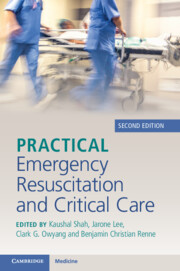Book contents
- Practical Emergency Resuscitation and Critical Care
- Practical Emergency Resuscitation and Critical Care
- Copyright page
- Contents
- Contributors
- Preface
- Section 1 General Critical Care
- Section 2 Infectious Disease Emergencies
- Section 3 Neurological Emergencies
- Section 4 Cardiovascular Emergencies
- Section 5 Respiratory Emergencies
- 22 Acute Respiratory Distress Syndrome
- 23 Upper Airway Emergencies
- 24 Asthma
- 25 Chronic Obstructive Pulmonary Disease
- 26 Massive Hemoptysis
- 27 Pulmonary Embolism
- Section 6 Gastrointestinal Emergencies
- Section 7 Renal Emergencies
- Section 8 Hematology–Oncology Emergencies
- Section 9 Endocrine Emergencies
- Section 10 Environmental Emergencies
- Section 11 Trauma
- Section 12 End of Life
- Index
- References
27 - Pulmonary Embolism
from Section 5 - Respiratory Emergencies
Published online by Cambridge University Press: 02 November 2023
- Practical Emergency Resuscitation and Critical Care
- Practical Emergency Resuscitation and Critical Care
- Copyright page
- Contents
- Contributors
- Preface
- Section 1 General Critical Care
- Section 2 Infectious Disease Emergencies
- Section 3 Neurological Emergencies
- Section 4 Cardiovascular Emergencies
- Section 5 Respiratory Emergencies
- 22 Acute Respiratory Distress Syndrome
- 23 Upper Airway Emergencies
- 24 Asthma
- 25 Chronic Obstructive Pulmonary Disease
- 26 Massive Hemoptysis
- 27 Pulmonary Embolism
- Section 6 Gastrointestinal Emergencies
- Section 7 Renal Emergencies
- Section 8 Hematology–Oncology Emergencies
- Section 9 Endocrine Emergencies
- Section 10 Environmental Emergencies
- Section 11 Trauma
- Section 12 End of Life
- Index
- References
Summary
Acute pulmonary embolism (PE) carries a high risk of morbidity and mortality and has a wide spectrum of severity, from incidental diagnosis in an asymptomatic patient to sudden refractory shock and cardiovascular collapse. Although the exact incidence remains uncertain, it is estimated that approximately 600,000 patients are diagnosed with PE annually in the United States, with mortality rates as high as 30% for patients with hemodynamic instability at presentation. A high-risk PE is one associated with hypotension or bradycardia. An intermediate-risk PE has evidence of RV strain, either by imaging or biomarkers (troponin or BNP). All others are low-risk PEs. The diagnosis of PE is often complicated by presentations that can be subtle, atypical or confounded by another coexisting disease.
Keywords
- Type
- Chapter
- Information
- Practical Emergency Resuscitation and Critical Care , pp. 242 - 254Publisher: Cambridge University PressPrint publication year: 2023

